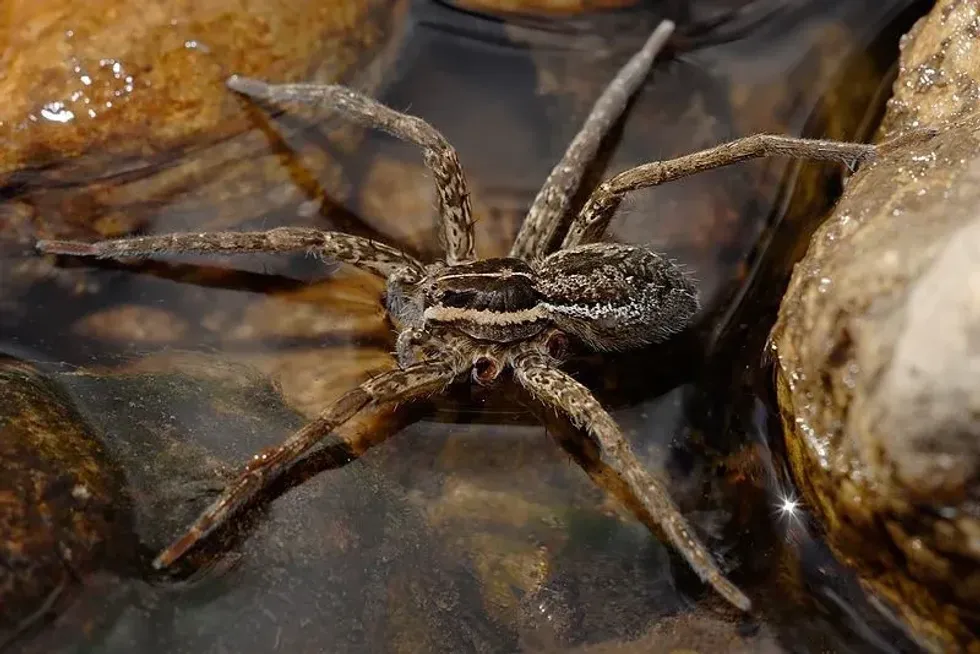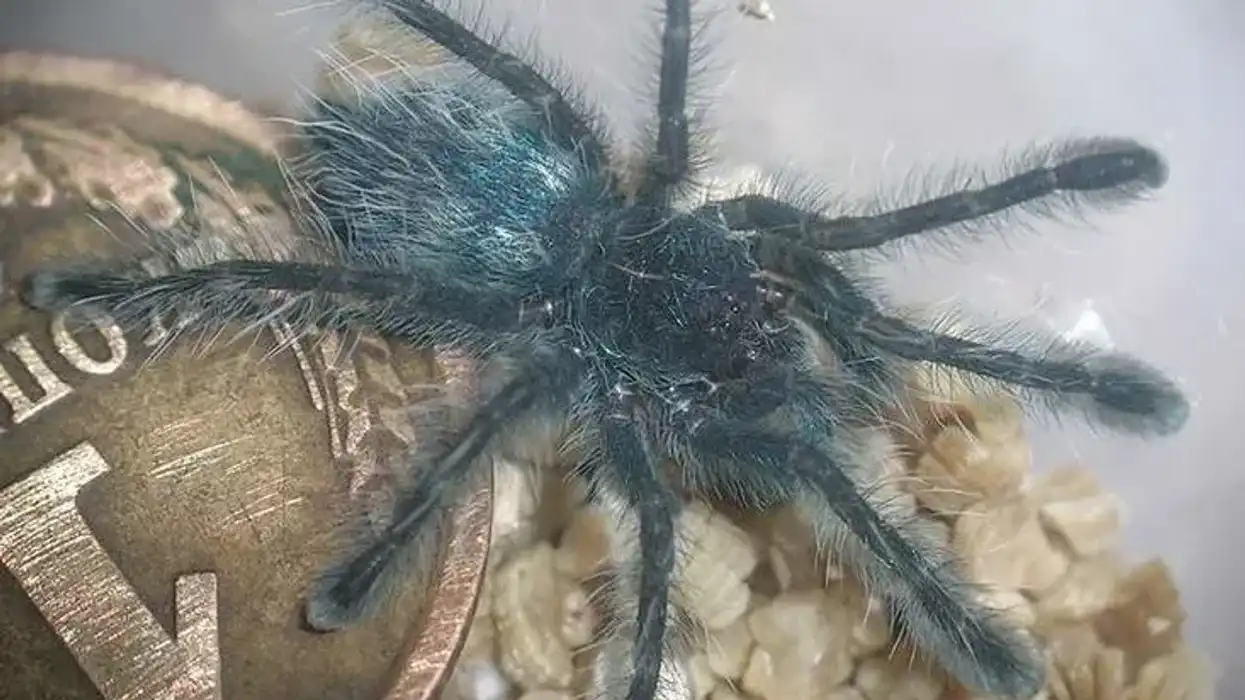Fishing spiders are also known as Dolomedes scientifically. The species is known by several other names such as raft spiders, dock spiders, or wharf spiders.
These spiders are found mostly in Mexico and Canada. Fishing spiders are semi-aquatic creatures. These species are have been named Dolomedes which has been derived from "dolomidis".
The meaning of the Greek derivation is wily, deceitful. Fishing spiders have velvety hydrophobic hairs all over their body. This carnivorous species mainly preys on small fishes and tadpoles.
They are common creatures of brown or tan color with light brown bands on their abdomen and are usually of the size 2.6-5.2 cm (1-2 in). They don’t make typical webs as they use moisture surfaces as a replacement for webs.
This common type of spider is venomous. Although, their venom is said to be harmless unless one is allergic to them. So, fishing spider bites aren't harmful.
Female fishing spiders are said to be larger than the male spiders. Moreover, female fishing spiders or Dolomedes are capable of laying a thousand eggs at once.
These venomous creatures are found in forests. Fishing spiders can invade your house's swimming pools and may get inside your clothes. This can be harmful as their bites can cause pain, similar to that of a bee sting.
If you enjoy reading this article, check out these wolf spider facts and mouse spider facts for more interesting spider facts!
Fishing Spider Interesting Facts
What type of animal is a fishing spider?
The fishing spider is a common species of spider. They have light brown or black bands on their legs and abdomen. There are also some white-banded fishing spiders and six spotted fishing spiders available.
What class of animal does a fishing spider belong to?
Fishing spiders belong to the Arachnida class of the Animalia family.
How many fishing spiders are there in the world?
Dark fishing spiders, as a common breed of spiders, are easy to find. Moreover, there are 100 species of them found all over the world.
Where does a fishing spider live?
Fishing spiders or Dolomedes are a water species and therefore live in environments with freshwater. They can be found in ponds and wetlands.
What is a fishing spider's habitat?
This species is found near water or wooded areas, mostly in North America. Their habitat is usually near any type of water body. The dark fishing spider is mainly found near lakes, ponds, wetlands. Since they have the ability to swim they can also be found underwater and on stones, docks, as well as ships.
Who do fishing spiders live with?
Fishing spiders prefer to live solitary like the other spider species. The adult male and female however can live with nursery web spiders. Mostly male and female Dolomedes live alone but the nursery web spiders move along with their parents.
How long does a fishing spider live?
Dolomedes or dock spiders usually live for 1-2 years. Female Dolomedes have a longer life span than the males. The average male dock spider is said to live for a year to a year and two months approximately. Whereas average female dock spiders can live up to two years approximately.
How do they reproduce?
Fishing spiders reproduce eggs when males and females mate with each other. However, a really cruel phenomenon of nature is that after mating the males die. This cannot be avoided in any condition.
In some cases, female Dolomedes eat their male partner after mating. The reason is unknown for such behavior on their part. Female Dolomedes produce a thousand eggs at once which stays attached in their egg sac in the beginning days.
What is their conservation status?
Fishing spiders are an extremely common species and can be found anywhere. Hence, they will not be extinct for centuries. Their status is currently Not Extinct.
Fishing Spider Fun Facts
What do fishing spiders look like?
Fishing spiders typically look like wolf spiders. However, they are larger than the Carolina wolf spider. Fishing spiders have a brown exoskeleton with black or light brown markings. They have four eyes arranged in two horizontal rows and long legs with black and brown-banded rings. Their eye arrangement is what differs them from other species.
How cute are they?
These large size spiders in general aren’t cute or friendly creatures. Fishing spiders may seem cute to some but others won't find them cute.
How do they communicate?
Dock spiders communicate through vibrations which are known as seismic communication. Through different levels of vibration, they warn rivals or catch prey. Some Dolomedes prey on their kinds (spiders) by mimicking the sound of insects.
How big is a fishing spider?
The average Dolomedes is bigger than a wolf spider. According to some sources, Dolomedes can be 42 times bigger than their prey size and some can be smaller. The length varies from 0.5-90 mm (0.01-3.5 in).
How fast can fishing spiders move?
They are capable of moving extremely fast and do not hesitate to hunt.
How much does a fishing spider weigh?
Fishing spiders weigh approximately 1-7 g (0.04-0.05 oz). However, a 7 g (0.05 oz) Dolomedes can easily catch a 30 g (1 oz) fish.
What are the male and female names of the species?
The name of the male and female species is Dolomedes or fishing spiders.
What would you call a baby fishing spider?
Fishing spider babies are called the same name as that of a regular spider. They are known as spiderlings.
What do they eat?
Dock spiders normally eat tadpoles, small fishes, and insects. They can sometimes prey on fishes that are 50 times their size.
Are they harmful?
Dock spiders aren’t harmful despite their large size. However, their bites can be venomous. Humans cannot be harmed by the venom of nursery web spiders unless they’re allergic to them.
If you are allergic to them you can get rid of them by using pests. There are specific pests meant for getting rid of adult and nursery web Dolomedes. You can hire a pest control for that.
Would they make a good pet?
Dolomedes can make a fascinating pet. They may not pay a lot of attention to you but they can be an interesting choice to have as a pet.
Did you know...
Dolomedes are fascinating creatures who can survive underwater. They are the species that have the ability to swim.
Their special velvety hydrophobic hair all over their body allows them to have movement time underwater and enables them to walk as well as swim. These creatures have some astonishing facts. Even though they weigh 7 g (0.05 oz), Dolomedes can prey upon a fish 42 times bigger than their size.
An average female Dolomedes produced up to a thousand eggs after mating with the male fishing spider. Did you know that the male is killed by the female spider after mating?
Male Dolomedes becomes immobile after mating and ends up dying. The reason as to why the female spider eats her mating partner is unknown but it’s a sad reality.
The average life span of a female Dolomedes is twice that of a male Dolomedes. It seems like nature has favored the female Dolomedes a lot more than the male.
Fishing spiders are often confused with wolf spiders because of their similar appearances. But they can be identified as different creatures from their larger body size and arrangement of eyes.
Fishing spiders aren’t harmful to human beings. They are venomous but their venom can cause no harm. If you still don't like them you can get pest control services. There are some specific pests that can help get rid of them.
Moreover, they can communicate by using different levels of vibrations. They often pretend to make the sound of prey to trap other spiders and eat their kind.
Dark fishing spider vs wolf spider
Dolomedes are often confused as wolf spiders because of their similar appearances. They both have a lot of similarities but a few noticeable factors which differentiate the two from each other. Dark fishing spiders and wolf spiders have the same body type.
They both have a brown or black exoskeleton with light brown or black bands on their body. They both have hairy bodies which allow them to swim or walk on water.
Now let us discuss the differences that can help you to differentiate between the two species. Wolf spiders have equal size eyes whereas fishing spiders have different-sized eyes that are arranged differently than wolf spiders. Fishing spiders also have a larger body size.
Fishing spider adaptations
Fishing spiders have been designed by nature for water bodies. Dark fishing spider habitats can be found in water environments, in a fishing spider web. They possess velvety hydrophobic hair all over their body which allows them to survive underwater, swim, and even walk on water.
Dark fishing spiders are found in water bodies and wooded areas so that they can hunt aquatic insects and catch small fish. They can be seen in wetlands, ponds, lakes, and other water bodies.
Fishing spiders do not need a web to prey. Waterworks as a web for them as it allows them to feel the vibration of their prey. This happens when they extend their legs on the surface.
Moreover, they mostly target water creatures like tadpoles, aquatic insects, and fishes. Irrespective of their size they are capable of taking down a fish 40 times their size. It seems as if no other place would be a better habitat for these water spiders to adapt to than water bodies.
Here at Kidadl, we have carefully created lots of interesting family-friendly animal facts for everyone to discover! For more relatable content, check out these jumping spider facts and hobo spider facts pages.
You can even occupy yourself at home by coloring in one of our free printable fishing spider coloring pages.










